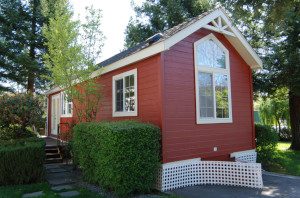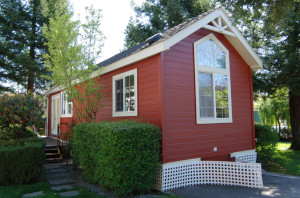How to Get Tiny House Insurance in 3 Simple Steps
According to the National Association of Home Builders, the average size of a new single-family home in the U.S. amounts to 2,641 square feet.
But this doesn’t necessarily mean everyone is looking for a house that comes with multiple bedrooms, bathrooms, and areas to entertain.
In fact, many Americans are joining the tiny house movement instead of settling in a larger living space.
What is a Tiny House?
 A tiny house is exactly what it sounds like. The Tiny Life reported that these smaller dwellings range between 100 and 400 square feet.
A tiny house is exactly what it sounds like. The Tiny Life reported that these smaller dwellings range between 100 and 400 square feet.
There aren’t any rules that signify what size a home becomes before it’s considered tiny, but these houses are generally 400 square feet and smaller.
The average tiny house includes a living area, sleeping loft, kitchen, and bathroom.
They are also constructed with a hitch to make it easy to move, enabling you to move virtually anywhere that’s permissible by zoning regulations.
What makes a tiny home so special, and why are so many Americans interested in stepping away from the traditional dwelling?
Downsizing is a major reason, as many people are choosing to live a simpler life with fewer belongings, which can ultimately result in less stress.
Cost and the elimination of the mortgage are also two strong reasons to consider moving to a tiny house.
The economy and the environment are constantly testing the ways we live on this earth, and downsizing can make it easier to cope with the ever-changing factors that can make owning a large home less comforting and wholesome than it once was.
Owning a tiny house can provide peace of mind in many aspects, but especially when it comes to money.
According to The Tiny Society, 89% of tiny house owners in the U.S. have less credit card debt than the average citizen.
Even better, 60% of owners live with virtually no credit card debt to begin with.
Data also shows that 55% of homeowners who live in a tiny house have greater savings in the bank than the average American.
Beyond the savings you may find down the road, the initial cost of a tiny house may also be appealing: Tiny homes can range between $8,000 and $150,000, according to Business Insider.
Even on the higher end, you can still benefit from owning a home that’s less than the average listing price in the U.S. In other words, investing in this nontraditional living arrangement may be the best option for you if you’re looking for financial relief.
Tiny House and Homeowners Insurance
Because small houses don’t comply with the codes and regulations that are expected of large dwellings, traditional homeowners insurance doesn’t exactly apply to tiny homes.
A tiny house is often on wheels, which means it doesn’t adhere to the rules that were created for an immobile structure. This makes it ineligible for a traditional insurance policy.
Of course, financing your tiny house and keeping it in one place means you don’t legally nor necessarily have to insure it.
Although, it’s always smart to cover any large investment you have, especially when it holds your personal property and provides comfort that you couldn’t find elsewhere.
If you do plan on moving your tiny house to a different location at one point (or mobilizing it indefinitely) you may need to consider a policy that’s similar to auto insurance.
If you plan on insuring your tiny house, you need to make sure it’s certified by the Recreational Vehicle Industry Association or the National Organization of Alternative Housing.
According to Policy Genius, many insurers won’t cover your tiny house unless it meets the standards to gain certification.
Coverage Options for a Tiny House
Because tiny homes can be mobile or fixed in a permanent location, there are various different coverage routes to consider.
There are numerous insurance options to consider for unique structures, such as RV or trailer insurance, comprehensive liability, personal property, or perhaps even a specialty insurance policy.
Again, the type of coverage you go with depends on whether you plan on moving your tiny house around or keeping it in a stationary location for a long period of time.
Overall, the average price for tiny house insurance is around $852 per year, according to Value Penguin.
However, the size and value of your tiny house will play a huge role in how much you end of investing in an annual insurance premium.
- RV or Mobile Home Insurance: A tiny home that’s on wheels is very similar to a recreational vehicle, which means RV or trailer insurance may be the best option for you. Many popular insurance companies that provide coverage across the nation have policies dedicated to RVs, so you can find insurance that enables you to move your tiny home freely from state to state with no worry. Because RV insurance is designed for a dwelling that’s on the move, you can rest assured that you have coverage in the event of a disaster occurring while you’re parked or traveling on the road. Tiny house homeowners who are interested in an RV policy must become certified by the RVIA before gaining a policy. So, if you built your own tiny house instead of working with a professional certified contractor, you may be ineligible for RV insurance, according to Value Penguin.
- Manufactured or Mobile Home Insurance: This is another option if your tiny house is fixed on a permanent location. Generally, this option covers the structure of the home from most included perils, and personal property on the inside is also insured. If you ever intend on hitching your tiny house and moving it to a different location, you need to add separate coverage, even if it’s just a temporary move.
- Personal Property Insurance: Some insurance companies may offer personal property coverage for your tiny house. This provides insurance on all personal belongings that reside inside the home, such as furniture, clothing, digital devices and more in the event of a covered loss. If you’re on the fence about investing in an insurance policy to cover your small living arrangement, this might be the best option for you, as you can have peace of mind knowing your limited personal belongings are safe.
- Specialized Insurance: This type of policy is perfect for a unique situation like owning a tiny house. A Homeowners insurance policy should never be considered a one-size-fits-all option, and specialized insurance and additional policies make it easier for those who don’t live in traditional settings. Companies like National General Insurance, for example, offer additional coverage policies for mobile and manufactured homes and other specialized dwellings and structures for home, liability and personal property.
How to Find a Policy
Finding a policy for your tiny house may seem trickier than gaining traditional homeowners insurance, but this doesn’t make it impossible.
Consider the following tips for insuring your small dwelling:
- Shop around: When you’re looking for something so specific, it’s easy to settle on the first policy you find. However, this can result in losing out on potential discounts and savings. Ask for referrals and shop around to find the best insurance policy.
- Do your research: While it may be less common to find a tiny house insurance policy, some companies will specialize in this home owning trend. Search the internet and pour your heart into research before committing to a policy.
- Find what’s right for you: Each tiny house is different, which means there’s a policy out there that will fit your unique situation. Don’t settle for something standard that may not provide the coverage you need in the event of a disaster.
To learn more about homeowners insurance policies and available options for unique situations, check out our top insurance company reviews.



